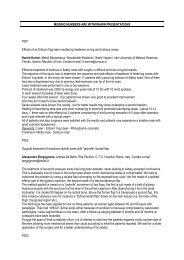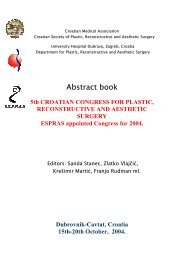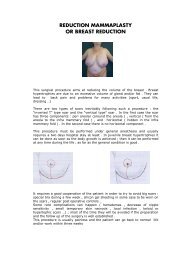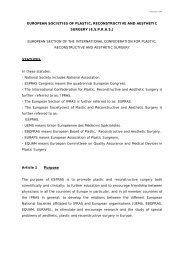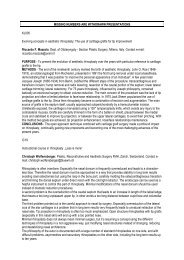Abstract book - ESPRAS
Abstract book - ESPRAS
Abstract book - ESPRAS
Create successful ePaper yourself
Turn your PDF publications into a flip-book with our unique Google optimized e-Paper software.
P 13. Our experience in wound closure with V.A.C.<br />
Jurišić D., Pirjavec A.<br />
Plastic Surgery Unit, Clinical Hospital Center, Rijeka, Croatia<br />
V.A.C. therapy is new non invasive meted, which acts on the principle of<br />
localized and controlled negative pressure, either continuous or intermittent<br />
that acts over the inert medication made of medical polyuretan. This<br />
material is porous, sterile, can be adapted to the wound size and does not<br />
contain any medicaments.<br />
Patient preparation<br />
- necrectomy,<br />
- shaving of the surrounding skin (if possible),<br />
- flush the wound with the saline solution,<br />
- dry up the skin around the wound,<br />
- choose appropriate length of the medication,<br />
- take care that the tubus is not placed to close to the wound.<br />
Changing the medication<br />
- every 48 hours ( if not indicated differently,<br />
- every 12 hours if the wound is infected (CFU >150).<br />
Changing the container with the exudat<br />
- when fluid level reaches 250cc,<br />
- once a weak no matter of fluid level.<br />
Indications<br />
- ulcus cruris,<br />
- decubital wounds,<br />
- preparation for surgical procedures (transplantation),<br />
- deep combustions,<br />
- infected surgical wounds.<br />
Contraindications<br />
- fistulae,<br />
- osteomielytis<br />
- malignant wounds.<br />
Results<br />
- the pictures of pre and post therapy status will be shown<br />
P 14. Comparison of transthecal to traditional block for anesthesia<br />
of the finger<br />
Keramidas E., Rodopuolou S., Tsoutsos D. Miller G., Ioannovich I.,<br />
Plastic Surgery, Northern General Teaching Hospital, Sheffield, UK<br />
Introduction<br />
Chiu in 1990 was the first to desccribe the transthecal (TT) digital block,<br />
using the flexor tendon sheath for anesthetic infusion. Our purpose was to<br />
compare the TT digital block with the traditional block (TD) with regards,<br />
the onset of time to achieve anesthesia and pain during the infiltration<br />
Materials and Methods<br />
A randomized double blind study was performed in 50 patients to compare<br />
the transthecal (TT) to traditional subcutaneous infiltration (TD)<br />
techniques of digital block anesthesia. All the patients had sustained injury<br />
involving two or four fingers of the hand. Each patient served as his/her



